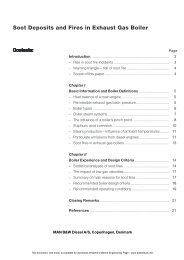Fire on Board the Liberian Passenger Ship Ecstasy, Miami, Florida ...
Fire on Board the Liberian Passenger Ship Ecstasy, Miami, Florida ...
Fire on Board the Liberian Passenger Ship Ecstasy, Miami, Florida ...
- No tags were found...
Create successful ePaper yourself
Turn your PDF publications into a flip-book with our unique Google optimized e-Paper software.
Analysis 56 Marine Accident Reportsubsequently lost propulsive power and most steering and had to be towed back to <strong>Miami</strong>.During <strong>the</strong> <strong>on</strong>board emergency, all passengers evacuated safely from <strong>the</strong> affected areas;however, two crewmembers became trapped <strong>on</strong> deck No. 2, and firefighting teams had torescue <strong>the</strong>m. Nine passengers were treated for injuries resulting from pre-existingc<strong>on</strong>diti<strong>on</strong>s or smoke inhalati<strong>on</strong>, and 14 crewmembers sustained minor injuries fromfirefighting activities and/or smoke inhalati<strong>on</strong>.<str<strong>on</strong>g>Fire</str<strong>on</strong>g> Igniti<strong>on</strong> and Propagati<strong>on</strong>Although Safety <strong>Board</strong> investigators found evidence of fire damage, smokedamage, or both in several aft areas of <strong>the</strong> <strong>Ecstasy</strong>, <strong>the</strong>y readily narrowed <strong>the</strong> potentialorigin of <strong>the</strong> fire to ei<strong>the</strong>r <strong>the</strong> aft mooring deck or <strong>the</strong> main laundry.The Safety <strong>Board</strong> examined <strong>the</strong> mooring deck because of <strong>the</strong> extensive firedamage to <strong>the</strong> area. Investigators c<strong>on</strong>sidered various sources of igniti<strong>on</strong>, includingelectrical malfuncti<strong>on</strong>s, discarded smoking materials, and accelerants. Electricalmalfuncti<strong>on</strong>s could have occurred in <strong>the</strong> three c<strong>on</strong>trol boxes for <strong>the</strong> winches. The wiring in<strong>the</strong> c<strong>on</strong>trol boxes had been exposed to intense heat and <strong>the</strong> insulati<strong>on</strong> <strong>on</strong> <strong>the</strong> wires in <strong>the</strong>boxes burned away. Investigators found no evidence of arcing or failure, however, in anyof <strong>the</strong> wiring. Examinati<strong>on</strong> of <strong>the</strong> motor c<strong>on</strong>troller panels for <strong>the</strong> winches, located in <strong>the</strong>steering gear room <strong>on</strong> deck No. 3, also revealed no failures.Investigators found no evidence that smoking materials had been discarded or anyinflammable liquids had been stored <strong>on</strong> <strong>the</strong> deck. Moreover, ATF testing of <strong>the</strong> debrissamples collected after <strong>the</strong> fire showed no evidence of any accelerant used to intenti<strong>on</strong>allyset <strong>the</strong> fire (ars<strong>on</strong>). The prol<strong>on</strong>ged fire <strong>on</strong> <strong>the</strong> mooring deck might have destroyed anyevidence of igniti<strong>on</strong> caused by smoking material or accelerants. O<strong>the</strong>r evidence, however,indicates that <strong>the</strong> fire did not originate <strong>on</strong> <strong>the</strong> mooring deck. Support for this c<strong>on</strong>tenti<strong>on</strong> isbased <strong>on</strong> <strong>the</strong> dynamics of air flow in <strong>the</strong> ventilati<strong>on</strong> systems c<strong>on</strong>necting <strong>the</strong> mooring deckto <strong>the</strong> laundry room, <strong>the</strong> c<strong>on</strong>diti<strong>on</strong> of <strong>the</strong> ventilati<strong>on</strong> systems, and <strong>the</strong> events that tookplace in <strong>the</strong> main laundry room before <strong>the</strong> sounding of <strong>the</strong> first fire alarm.A pathway was necessary for fire to have spread from <strong>the</strong> mooring deck to <strong>the</strong>main laundry. C<strong>on</strong>diti<strong>on</strong>s existed, however, that would have prevented <strong>the</strong> fire fromspreading in this manner. Before <strong>the</strong> master ordered <strong>the</strong> shut down of <strong>the</strong> powerventilati<strong>on</strong> system in MVZs 1 and 2, two ventilati<strong>on</strong> duct systems from <strong>the</strong> main laundry,separately servicing <strong>the</strong> dryers and <strong>the</strong> mangle, exhausted air into <strong>the</strong> mooring deck at arate of roughly 7 meters per sec<strong>on</strong>d. If <strong>the</strong> fire had originated in <strong>the</strong> mooring deck andspread to <strong>the</strong> main laundry, <strong>the</strong> flames would have had to travel through <strong>on</strong>e or both of <strong>the</strong>duct systems in <strong>the</strong> opposite directi<strong>on</strong> of <strong>the</strong> exhaust airflow. Based <strong>on</strong> Safety <strong>Board</strong>calculati<strong>on</strong>s and in accord with current research <strong>on</strong> flame movement, <strong>the</strong> flames could nothave traveled against an airflow of such velocity. 4747 A.C. Fernandez-Pello and T. Hirano, “C<strong>on</strong>trolling Mechanisms of Flame Spread,” Combusti<strong>on</strong>Science and Technology, Vol. 32, (1983): 1-31.
















